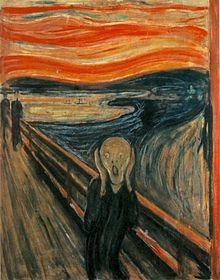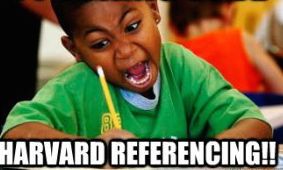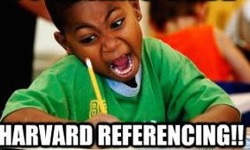PROJECT BRIEF - CRITICAL RESEARCH REPORT
The structure and final presentation guidelines for the CRITICAL RESEARCH REPORT are taken from:
Cottrell (2014).
Cottrell (2014).
 Don't let it get you down...
Don't let it get you down...
1. WHAT? (research and write about something you are interested in...)
- THE CRITICAL RESEARCH REPORT (DISSERTATION) is the written and illustrated presentation of independent research on a subject of your own choice.
- The subject for research should be from fashion and textiles. It is not compulsory for your subject to relate directly to your studio practice but if it does this can be useful for both personal and professional development plus is an important part of the REFLECTIVE JOURNAL.
Last year's BA3 subjects
- Research into your subject should begin with the historical, technical and social context. It should then develop a theoretical perspective in order to demonstrate critical awareness.
Example essay plan
To consider the pressure on female celebrities to stay young (with particular reference to Kate Middleton)
To consider the pressure on female celebrities to stay young (with particular reference to Kate Middleton)
1. The importance of youth and celebrity in contemporary culture (historical and technical)
2. The role of the media (social)
3. Gender and sexism (theoretical)
The inverted triangle approach to planning (start with the bigger picture and proceed to the smaller detail)
2. The role of the media (social)
3. Gender and sexism (theoretical)
The inverted triangle approach to planning (start with the bigger picture and proceed to the smaller detail)
youth and celebrity
media
gender and sexism
media
gender and sexism
- Research should take one of the theoretical perspectives introduced in BA1 INTRODUCTION TO FASHION THEORY as a starting point for discussion.
Theory can make your scream...
The word 'theory’ is a grand term that is intimidating and frightening to many students and even scholars. (Kawamura, 2011, p.20).
But it also makes you think...
Theories help us organise our otherwise disorganised world, make sense of it, guide us how we behave in it or we should behave in it, and also helps us predict what might happen in the future.
(Kawamura, 2011, p.20).
The word 'theory’ is a grand term that is intimidating and frightening to many students and even scholars. (Kawamura, 2011, p.20).
But it also makes you think...
Theories help us organise our otherwise disorganised world, make sense of it, guide us how we behave in it or we should behave in it, and also helps us predict what might happen in the future.
(Kawamura, 2011, p.20).
- All subjects will require considerable secondary research (books, articles, newspapers etc) and some subjects may develop primary research (surveys, questionnaires, interviews etc).
https://scholar.google.co.uk
https://www.surveymonkey.com
- The report should include in-text citations and quotations from your secondary research (Harvard).
- The report should include a BIBLIOGRAPHY for all reading and a REFERENCE LIST for in-text citations and quotations (Harvard).
What is the difference between a reference list and a bibliography?
See the REFERENCING, QUOTE OF THE WEEK/NEWS STORY OF THE WEEK pages, plus referencing software
https://www.mendeley.com
http://www.neilstoolbox.com/bibliography-creator/
(student recommended...)
https://www.mendeley.com
http://www.neilstoolbox.com/bibliography-creator/
(student recommended...)
THE MOST COMMON QUESTION I GET ASKED ABOUT REFERENCING IS HOW DO I REFERENCE A QUOTE WHICH HAS BEEN QUOTED IN A BOOK I AM READING?
This means that you want to cite something by an author which has already been cited in a book you are reading.
Ideally you should find and read the original source referred to...
If this is not possible you use the words 'cited in' and give the page number and reference for the author where you have discovered it.
This means that you want to cite something by an author which has already been cited in a book you are reading.
Ideally you should find and read the original source referred to...
If this is not possible you use the words 'cited in' and give the page number and reference for the author where you have discovered it.
- BA1 = 2000 words
- BA2 and BA3 = 4000 words
Fifteen hours of Art over two whole days, that was, just like, a punishment or something, not an exam. You weren't allowed out of the room or anything except for lunch and breaks and toilet breaks and stuff. It was like, so harsh? I have decided that even if it ever turned out that I was quite a good artist, I really don't want an artist's actual life. Not a painter anyway. All you do all day is paint and look at it and paint and look at it. By the end of these last two days I am so fed up looking at it, I never want to see it ever again. I never want to see the Art room ever again, it feels like I've been in there my whole life since the day I was born. And it's all been leading up to this day, the day I can say that's the last Art day I will ever do. Even though the teacher was saying, "Come on, Dora, stop talking and get painting, you can do it. Go Dora!' and stuff, I still feel like I've just spent fifteen hours working on something that's just going to be rubbish in the end. Nearly everything I do is rubbish. I know it is. I'm not dumb. I can see that other people are doing way better than me.
Anyway, it doesn't matter, it's done now and I've only got one cookery theory exam before I finish school forever. Omigod, no more school! Bring it on baby, yeh. What's it gonna be like? Oh, is that the alarm ringing at 7AM? Is it for me to get up and put on a rank burgundy and grey disgusting school uniform with absolutely zero taste? No - it isn't - because Dora Battle doesn't go to school anymore. Bye school! Seeya! Hasta La Vesta, school! Bon voyage!
Why is studying text books so effing hard? I tried to be dyslexic way back in Year 8, because they get extra time and wordsearch and spellcheck and stuff but apparently I'm not, which is really annoying. At least I did find out that I need glasses so that's something. Not sure that totally 125% explains why I hate reading though. It could be because I actually just hate reading, words and sentences, and textbooks 'n' shizz. BUT What's really interesting, and I think the government should like wake up and realise this about young people today, is that I really do love reading Facebook and MSN 'n' stuff, and that is, after all, reading isn't it? It's still words.' (French, 2011, p.219-220).
The above quotation is just over 400 words
MATHS ALERT... NUMBERS!
What are numbers?
Our system of counting works by grouping things together in tens, putting tens of tens together to make hundreds, to make thousands and so on. The choice of working in tens is, of course, down to the fact that we have ten fingers (or digits) on our hands - and ten on our test, too, just for good measure,
So familiar is this system of tens ('deci-mals') to us, it seems almost natural - it's just how numbers are. But the idea of place value as we know it, with Hundreds, Tens, Units and the rest, and its use daily with money and measures, is only a few hundred years old. Just as it takes children many years to learn to 'decode' written symbols and become proficient readers, so it takes an equally long time for them to become proficient with our invented system of saying, reading and writing numbers. (Eastway and Askew, 2013, p.51).
MATHS ALERT OVER
2. HOW? (structure, final presentation, writing style...)
The report should follow this structure
(1, 2 and 3 = the essay, the rest is part of the final presentation. See PROJECT INFORMATION - CRITICAL RESEARCH PRESENTATION STRUCTURE)
(1, 2 and 3 = the essay, the rest is part of the final presentation. See PROJECT INFORMATION - CRITICAL RESEARCH PRESENTATION STRUCTURE)
- Abstract
- Title page
- Contents page
- 1. Introduction - to include a literature review and methodology.
- 2. Discussion and evaluation of key ideas and results from research - this section can be divided into subsections.
- 3. Conclusion
- Bibliography
- References
- Appendices (if relevant)
The report should follow this final presentation
- Printed on A4 (1.5 or 2 line spacing, font size 11-12) on one side of the paper only
- Leave clear margins at each side
- Use a font that is easy to read - Ariel or Tahoma
- Pages to be numbered and include page numbers on the Contents page
- Sections to be labelled - sections 1, 2 and 3 can include subsections 1.1, 1.2, 1.3 etc.
- Illustrations can be either inserted within the text or presented separately at the end before the Bibliography and References
- Illustrations to be labelled as they appear and as they are discussed within the text - Figure 1 etc
- Spiral bound - 2 copies to be submitted
The report's writing style should be:
- Formal - no slang or abbreviations
- Academic - in-text citations and quotations should follow the Harvard Referencing style
3. WHY? (learning outcomes...)
The learning outcomes which are important for the assessment of the CRITICAL RESEARCH REPORT are in bold underlined
- To self-manage ongoing independent academic research on subjects of personal interest within fashion and textiles.
- To show understanding of the relationship between academic research and studio practice.
- To show knowledge of the historical, technical and social development of post-industrial fashion and textiles.
- To show awareness of theoretical issues within fashion and textiles.
- To present research (secondary and original) in an academic form (written and verbal) conforming to academic conventions (Harvard reference system).
- To show analysis and evaluation of research.
4. WHEN? (hand in ... )
BA3 = 23 February 2017
5. ASSESSMENT
The CRITICAL RESEARCH REPORT will be assessed on:
- SELF-MANAGEMENT - RESEARCH FILE and REFLECTIVE JOURNAL
- HISTORICAL, TECHNICAL and SOCIAL - general background contextualisation
- THEORETICAL - theoretical perspective
- ANALYSIS and EVALUATION comprehension and critical awareness of key texts and issues
- REFERENCING and PRESENTATION - Harvard referencing and final presentation
REFERENCES
Brown, C. (2016) 'Animal to accessory - do designers really know where their products come from?' Critical research report. BCOT, University of Winchester.
Cottrell, S. (2014) Dissertations and project reports - a step by step guide. Basingstoke: Palgrave Macmillan.
Eastway, R. and Askew, M. (2013) Maths for mums and dads. Revised edn. London: Square Peg.
French, D. (2011 [2010]) A tiny bit marvellous. London: Penguin.
Hawker, S. (2016) 'To what extent did Princess Diana learn to use fashion to convey emotion and messages through the media?' Critical research report. BCOT, University of Winchester.
Hazel, L. (2016) 'Haute Couture - or totally ridiculous?' Critical research report. BCOT, University of Winchester.
Jeffrey, J. (2016) 'Appropriation: acceptable or simply glorified racism?' Critical research report. BCOT, University of Winchester.
Kawamura, Y. (2011) Doing research in fashion and dress. Oxford: Berg.
Lee, L. (2016) 'Did the black beret hold the real "black power" with regards to the Black Panther Party?' Critical research report. BCOT, University of Winchester.
Porter, N. (2016) 'Fashion and passion: the sexualisation of women through porn culture and the marketing of sexuality with fashion.' Critical research report. BCOT, University of Winchester.
Steele, K. (2016) 'How are protein based fabrics produced and are they less environmentally and ethically friendly than cellulose fabrics?' Critical research report. BCOT, University of Winchester.
Brown, C. (2016) 'Animal to accessory - do designers really know where their products come from?' Critical research report. BCOT, University of Winchester.
Cottrell, S. (2014) Dissertations and project reports - a step by step guide. Basingstoke: Palgrave Macmillan.
Eastway, R. and Askew, M. (2013) Maths for mums and dads. Revised edn. London: Square Peg.
French, D. (2011 [2010]) A tiny bit marvellous. London: Penguin.
Hawker, S. (2016) 'To what extent did Princess Diana learn to use fashion to convey emotion and messages through the media?' Critical research report. BCOT, University of Winchester.
Hazel, L. (2016) 'Haute Couture - or totally ridiculous?' Critical research report. BCOT, University of Winchester.
Jeffrey, J. (2016) 'Appropriation: acceptable or simply glorified racism?' Critical research report. BCOT, University of Winchester.
Kawamura, Y. (2011) Doing research in fashion and dress. Oxford: Berg.
Lee, L. (2016) 'Did the black beret hold the real "black power" with regards to the Black Panther Party?' Critical research report. BCOT, University of Winchester.
Porter, N. (2016) 'Fashion and passion: the sexualisation of women through porn culture and the marketing of sexuality with fashion.' Critical research report. BCOT, University of Winchester.
Steele, K. (2016) 'How are protein based fabrics produced and are they less environmentally and ethically friendly than cellulose fabrics?' Critical research report. BCOT, University of Winchester.






